One spot squeaker - Synodontis notatus
Scientific name: Synodontis notatus
Common name: One spot squeaker
Family: Mochokidae
Usual size in fish tanks: 20 - 25 cm (7.87 - 9.84 inch)
014
Recommended pH range: 6 - 7.5
Recommended water hardness: 4 - 12°N (71.43 - 214.29ppm)
0°C 32°F30°C 86°F
Recommended temperature range: 22 - 26 °C (71.6 - 78.8°F)
The way how these fish reproduce: Spawning
Where the species comes from: Africa
Temperament to its own species: aggressive/territorial
Temperament toward other fish species: peaceful
Usual place in the tank: Bottom levels
General Information
Synodontis notatus, the One Spot Squeaker, is a robust upside-down catfish from the Congo Basin. It is named for the single dark ocellus (spot) on the body, though the exact position/size can vary. Juveniles are often sold small but this species commonly reaches 20–25 cm (8–10″) in aquaria, with a correspondingly strong bio-load.
Food & Feeding
Omnivorous benthic forager. Use sinking catfish wafers/pellets as a staple and rotate meaty items (frozen bloodworms, krill, mysis, chopped shrimp) with some plant/algae content (spirulina wafers, blanched zucchini). Feed after lights-out or at dusk to match its crepuscular/nocturnal habits. Remove leftovers to protect water quality.
Sexing
No reliable colour dimorphism. Mature females are typically fuller-bodied; accurate sexing in Synodontis usually relies on examination of the genital papilla by experienced keepers. „Red dorsal“ as a male cue is not a consistent indicator.
Breeding
Hobbyist breeding is rare to unreported for this species. In nature they are egg scatterers; commercial propagation of some Synodontis uses hormonal induction and large outdoor ponds. Treat S. notatus as display-only unless you have specialist facilities.
Lifespan
Typically 8–12 years with clean, well-oxygenated water; longer is possible in large, stable systems.
Tank Requirements & Water Parameters
- Tank size: long footprint from 120 cm / 4′ (≈300 L/80 gal) for a single adult; larger if keeping multiples.
- Water: pH 6.0–7.5; hardness ~4–12 °dH; temperature 22–26 °C (72–79 °F). Stability is more important than the absolute number.
- Filtration & oxygen: robust mechanical/biological filtration and high aeration; keep nitrogenous waste low.
- Aquascape: sand or smooth fine gravel, plenty of caves (rock piles, pipes), and driftwood; dim/subdued lighting is appreciated.
- Maintenance: weekly water changes; avoid abrupt parameter swings.
- Handling: use containers rather than nets when possible—pectoral and dorsal spines can snag and puncture.
Compatibility & Tank Mates
With other species: generally peaceful toward robust, similarly sized tank mates (larger tetras/barbs, Congo tetras, rainbowfish, peaceful cichlids, other medium/large catfish). Avoid tiny fish and delicate long-finned species—nighttime predation/nipping can occur.
With conspecifics: can be territorial, especially as juveniles/subadults; expect mouth-wrestling and chasing. Keeping a single specimen or a well-spaced group in a very large tank with abundant hides reduces conflict.
Behaviour & Usual Place in the Tank
Nocturnal/crepuscular bottom-dweller that also cruises the lower mid-water when settled. Often rests inverted under wood/rock overhangs; more active after dark.
Short Description
One Spot Squeaker is a hardy Congo Synodontis with a distinctive single flank spot. Provide a roomy, well-filtered tank with caves, stable soft-to-moderately hard water and a varied sinking diet. Peaceful with most larger community fish, but expect territorial spats with conspecifics and avoid very small tank mates.
Q&A
- Does it eat plants? Typically not, but it may uproot soft plants while foraging; anchor plants well or use tougher species/anubias on wood.
- Why is mine shy by day? Normal—this species is crepuscular/nocturnal. Add caves and feed at dusk.
- Can I keep a group? Yes, but only in a large tank with many hides; expect some sparring as hierarchies form.
Pictures
Bought by aqua-fish.net from jjphoto.dk.
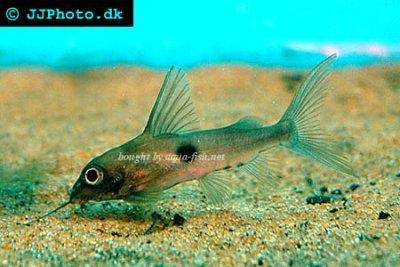


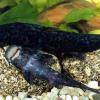 Euchilichthys
Euchilichthys 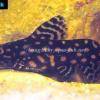 Angel
Angel 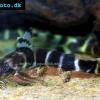 Brichard’s
Brichard’s  Decorated
Decorated 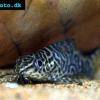 Featherfin
Featherfin 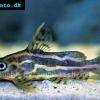 Orangestriped
Orangestriped 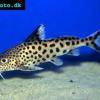 Cuckoo
Cuckoo 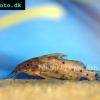 Lace
Lace 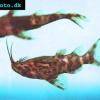 Upside-down
Upside-down 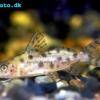 Ocellated
Ocellated 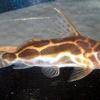 Robert’s
Robert’s